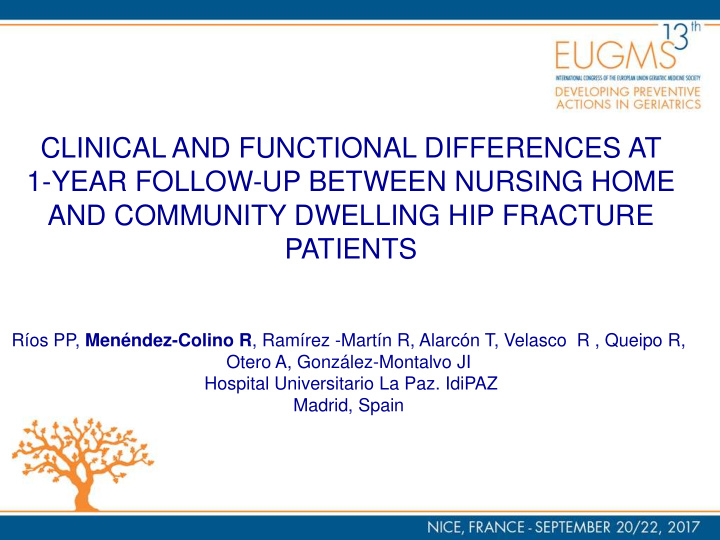



CLINICAL AND FUNCTIONAL DIFFERENCES AT 1-YEAR FOLLOW-UP BETWEEN NURSING HOME AND COMMUNITY DWELLING HIP FRACTURE PATIENTS Ríos PP, Menéndez-Colino R , Ramírez -Martín R, Alarcón T, Velasco R , Queipo R, Otero A, González-Montalvo JI Hospital Universitario La Paz. IdiPAZ Madrid, Spain
CONFLICT OF INTEREST DISCLOSURE No potential conflict of interest to report
INTRODUCTION • Hip fracture (HF) has an estimated incidence of 620000 cases per year in the European Union in 2010 • 17%-40% of HF patients came from nursing home • Nursing home HF patients have more functional impairment, more comorbidities and maybe worst outcome after hip fracture • Most studies including nursing home HF patients have a short follow-up, a limited number of variables and small series of patients
OBJECTIVE The aim of this study was to know if there are differences in clinical and functional outcomes at 1-year of follow-up. Nursing home (NH) Community dwelling (CD)
METHODS • All patients admitted with HF to a co-managed orthogeriatric unit in a 1,100-bed university hospital were included. • A geriatric assessment protocol: function (Barthel Index, Functional Ambulation Categories (FAC) scale, hand grip strength) , nutrition (body mass index, total protein, albumin), bone metabolism (vitamin D), pain and anaemia (FONDA protocol).
METHODS • Patients were classified in two groups in function of their previous place of residence. • Patients were assessed at two moments: – In the first 72 hours of admission – One year later were contacted by telephone and requested about vital and functional status and readmissions. • Decline in Functional Ambulatory Category scale was defined as - Mild : If the patient had 1 point decline in FAC scale - Moderate/severe : If the patient had ≥2 points decline in FAC scale
RESULTS 509 patients were included Place of residence
Baseline characteristics of Community-dwelling and nursing home hip fracture patients. Results as mean ( ± standard deviation), median (interquartile range) or number (percentage) p Nursing home Community Number 116 (22.8) 393 (77.2) Age (years) 88,5 (85-92) 85 (80-90) <0.001 Women 92 (79.3) 311 (79.1) ns Asessment Barthel Index 55 (36.25-80) 90 (75-100) <0.001 Funcional Ambulatory Category <0.001 0 11 (9.5) 7 (1.8) 1 a 3 34 (29.3) 54 (13.7) 4 a 5 71 (61.2) 332 (84.5) Technical aids 64 (68.1) 174 (48.6) 0.001 Red Cross Mental Scale >1 60 (51.7) 105 (26.7) <0.001 Diseases Heart Disease 46 (39.7) 149 (37.9) ns COPD 11 (9.5) 35 (8.9) ns Ictus 19 (16.4) 54 (13.7) ns Diabetes 27 (23.3) 92 (23.4) ns Renal failure 31 (26.7) 109 (27.7) ns Cancer 23 (19.8) 42 (10,7) 0.001 On antiagregant/anticoagulant drugs 58 (50.0) 182 (46.3) ns
In-hospital evolution of community-dwelling and nursing home hip fracture patients. Results as mean ( ± standard deviation) or number (percentage) Nursing home Community p Operated on 108 (93.1%) 383 (97.5%) 0.026 9.2 ( ± 4.0) 10.4 ( ± 5.2) Length of stay 0.013 In-hospital mortality 4 (3.4%) 17 (4.3%) 0.796 Destination at discharge Own home 0 (0%) 126 (32.1%) <0.001 Nursing home 108 (93.1%) 24 (6.1%) Intermediate Unit 4 (3.5%) 223 (56.8%) Lost 0 (0%) 3 (0.8%)
RESULTS At 1 year follow-up NH patients had a similar hospital readmissions (p=0.479)
RESULTS At 1 year follow-up NH patients had a similar mortality rate than CD patients (p=0.201)
Baseline and 1-year-post-fracture Functional Ambulatory Category (FAC) in conmmunity dwelling and nursing home patients (p<0.001)
Change on Functional Ambulation Category (FAC) since baseline to 1- year post-fracture in community-dwelling and nursing home patients (Mild Change: Baseline FAC – 1-year FAC = 1; Big Change: Baseline FAC – 1- year FAC = ≥2) (p<0.001).
CONCLUSIONS • Nursing home HF patients: – Had a worst baseline functional and mental situation. – If treated by means of a specific orthogeriatric assessment and management protocol did not die or were readmitted more frequently at 1-year follow-up. – Reached their baseline gait ability less frequently and had more functional decline than CD patients. • It may be to intensify rehabilitation of these patients in order to improve their functional outcomes
THANK YOU FOR YOUR ATTENTION
Recommend
More recommend